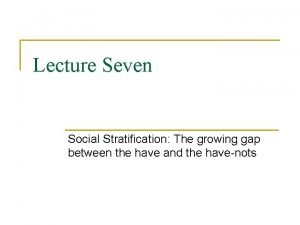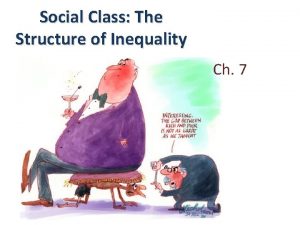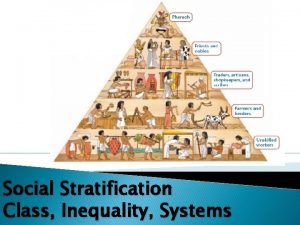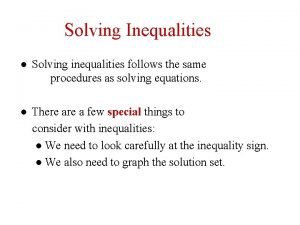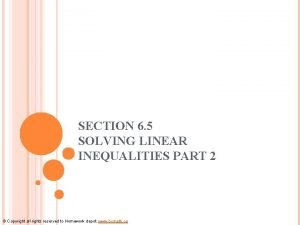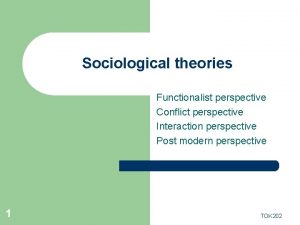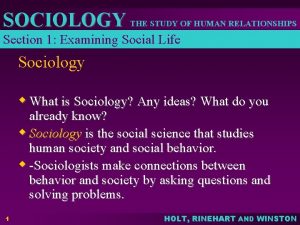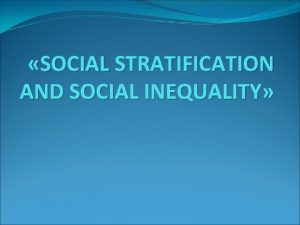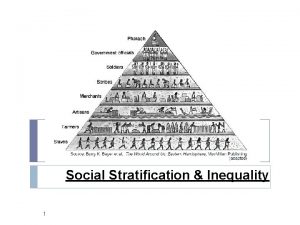Conflict Perspective Social Conflict of Inequality How does

















- Slides: 17

Conflict Perspective Social Conflict of Inequality

How does the Conflict Perspective view deviance? • Conflict theorists view social conflict, in the form of inequalities or power differentials, as the cause of deviance

Conflict Theory • Many assume that the law treats citizens equally and it serves the best interest of society • Are the laws on the books fair? • According to William Chambliss, we need to look at the law in action at how legal authorities discharge their duties – Authorities are unfair and unjust- favoring the rich and powerful over the poor and weak

Who is to blame for the unjust law? • Richard Quinny blamed unjust law directly on the capital system ▫ “Criminal law is used by the state and the ruling class to secure the survival of the capitalist system”

The Dominant Class • This involves the dominant class’s doing 4 things: – Defines criminals as those behaviors that threaten their interests • Robbery, murder, etc. – It hires law enforcers to apply those definitions and protect its interests – It exploits the subordinate class by paying low wages so that the resulting oppressive life conditions virtually force the powerless to commit crimes – It uses the criminal actions to spread and reinforce the popular view that the subordinate class is dangerous

Marxists • The capitalist’s ceaseless drive to increase profits by cutting labor costs has created a large class of unemployed workers ▫ Marginal surplus population-useless to the economy ▫ Compelled to commit property crimes to survive • The exploitive nature of capitalism causes violent crimes and noncriminal deviance

Marxist Continued • Monopolistic nature of capitalism encourages corporate crime b/c “when only a few firms dominate a sector of the economy they can more easily [plot] to fix prices, divide up the market and eliminate competitors”

Sheila Balkan • Argues that economic marginality leads to a lack of self-esteem and a sense of powerlessness and alienation, which create intense pressures on individuals ▫ Turn to violence to vent their frustrations and strike out against symbols of authority

The advantage of the Conflict Theory • Useful when explaining why most laws favor the wealthy and powerful and why the poor and powerless commit most of the unprofitable crimes in society • Useful when explaining why crime rates began to soar after the communist countries of the former Soviet Union and Eastern Europe turned to capitalism • Theory has been criticized for implying the all laws are unjust and that capitalism is the source of all crimes

Power Theory • Power inequality affects the type of deviant activities likely to be engaged in – The powerful are more likely to perpetrate profitable crimes in society (corporate crime) while the powerless are more like to commit unprofitable crimes (homicide, assault) • Power can also be a cause of deviance – More likely for a bank executive to cheat customers quietly that for a jobless person to rob banks violently

Why is deviance more common among the powerful? 1. Strong deviant motivation ▫ Stems from relative deprivation- feeling unable to achieve relatively high aspirations � Aspirations are too high and can’t be realized 2. Greater opportunities for deviance ▫ Access to better opportunities that make it easier to be deviant (think about the bank employee example)

Why is deviance more common among the powerful? 3. Powerful are subjected to weaker social control ▫ Laws against high-status criminals is relatively lenient and seldom enforced �Not a single corporate criminal has even been sentenced to death for marketing an untested drug that “cleanly” kills many people

Feminist Theory • Feminist argue that many theories about deviance are only applied to men ▫ The theories may be valid for male behavior but not necessarily for females

Feminist attack on Merton’s Strain Theory • The theory assumes that people are inclined to strive for material success – Women are traditionally less interested in achieving material success • Assumes that women who have a strong desire for economic success but limited access to opportunities are as likely as men to commit a crime – Data does not support this, women have not been as likely to commit crimes when not given legitimate opportunities for success

Feminists and Merton’s Theory • Strain theory explicitly states that Americans are likely to commit a crime b/c their society overemphasizes the importance of holding high goals while failing to provide the necessary means for all citizens to achieve those goals ▫ More relevant to men than women – women have lower crime rates

Feminist Theory focus • Deals with women as victims (mostly of rape and sexual harassment) – Crimes against women are said to reflect the patriarchal society’s attempt to put women in their place • Deals with women as offenders – Recent increase in female crime has not been great enough to be significant – Criminal opportunities are still much less available to women

Female offenders • When women do commit crime, it tends to be the type that reflects their subordinate position on society ▫ Minor property crimes- shoplifting, passing bad checks, welfare fraud, petty credit card fraud ▫ Reflects the increasing feminization of poverty �Most women criminals are unemployed, high school dropouts, single mothers
 1-6 solving compound and absolute value inequalities
1-6 solving compound and absolute value inequalities Social stratification vs social inequality
Social stratification vs social inequality 1 point perspective drawing boxes
1 point perspective drawing boxes Silo perspective vs business process perspective
Silo perspective vs business process perspective Inequality examples in society
Inequality examples in society Class inequity
Class inequity Functionalism social inequality
Functionalism social inequality Inequality stratification
Inequality stratification Social inequality definition
Social inequality definition Inequality math definition
Inequality math definition When does the inequality sign flip
When does the inequality sign flip Social thinking social influence social relations
Social thinking social influence social relations Social thinking social influence social relations
Social thinking social influence social relations Functionalist vs conflict theory
Functionalist vs conflict theory Structural functionalism definition
Structural functionalism definition Conflict perspective on education
Conflict perspective on education Conflict theory sociology
Conflict theory sociology Sociology the study of human relationships textbook
Sociology the study of human relationships textbook

